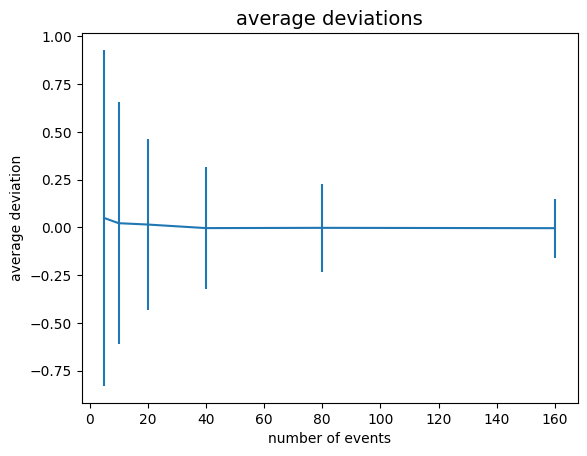10.11. Maximum likelihood exercise solutions#
10.11.1. Exercise 10.1#
Write a library of functions to determine the parameter τ of an exponential distribution from a list of numbers filled with pseudo-random numbers distributed according to an exponential probability density distribution.
Compare the result obtained with the mean of the numbers saved in the list.
How does the result depend on the initial interval passed to the
sezione_aurea_max_LLfunction?
from myrand import generate_exp
from likelihood import sezioneAureaMax_LL, exp_pdf, loglikelihood
tau_true = 2.
N_evt = 50
sample = generate_exp (tau_true, N_evt)
tau_hat = sezioneAureaMax_LL (loglikelihood, exp_pdf, sample, 0.5, 5., 0.0001)
print ('il valore di tau che massimizza il logaritmo della verosimiglianza è:', tau_hat)
il valore di tau che massimizza il logaritmo della verosimiglianza è: 1.8939418753389432
10.11.2. Exercise 10.2#
Plot the profile of the likelihood function and the point identified as its maximum.
from likelihood import loglikelihood
import matplotlib.pyplot as plt
import numpy as np
fig, ax = plt.subplots ()
ax.set_title ('Log-likelihood scan', size=14)
ax.set_xlabel ('tau')
ax.set_ylabel ('log likelihood')
tauaxis = np.linspace (0.5, 5., 10000)
ll = np.arange (0., tauaxis.size)
for i in range (tauaxis.size) :
ll[i] = loglikelihood (tauaxis[i], exp_pdf, sample)
plt.plot (tauaxis, ll, 'r')
plt.plot ([tau_hat, tau_hat],ax.get_ylim (), color = 'blue')
plt.text (tau_hat * 1.1, plt.ylim ()[0] + 0.1 * (ax.get_ylim ()[1] - ax.get_ylim ()[0]), 'tau_hat =' + str (tau_hat))
plt.show ()
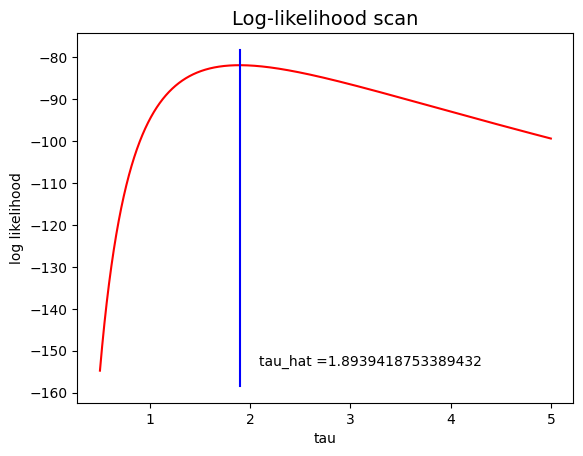
10.11.3. Exercise 10.3#
Modify the
sezione_aurea_max_LLfunction, adding the printing of the interval endpoint values at each iteration, to observe the narrowing of the interval during program execution.
10.11.4. Exercise 10.4#
Modify the
loglikelihoodfunction to calculate the logarithm of the product of the values of the probability density function, rather than the sum of individual logarithms. How does the algorithm’s behavior change?
from myrand import generate_exp
from likelihood import loglikelihood_prod
N_evt_big = 500
sample_big = generate_exp (tau_true, N_evt_big)
N_evt_test = 10
tau_hat_sums = []
tau_hat_pros = []
N_evt_range = []
while (N_evt_test <= N_evt_big) :
subsample = sample_big[:N_evt_test]
tau_hat_sums.append (sezioneAureaMax_LL (loglikelihood, exp_pdf, subsample, 0.5, 5., 0.0001))
tau_hat_pros.append (sezioneAureaMax_LL (loglikelihood_prod, exp_pdf, subsample, 0.5, 5., 0.0001))
N_evt_range.append (N_evt_test)
N_evt_test = N_evt_test * 2
fig, ax = plt.subplots ()
ax.set_title ('tau_hat estimates', size=14)
ax.set_xlabel ('number of events')
ax.set_ylabel ('tau_hat')
ax.plot (N_evt_range, tau_hat_sums, color = 'red', label = 'sum')
ax.plot (N_evt_range, tau_hat_pros, color = 'blue', linestyle = "dashed", label = 'product')
ax.legend ()
print ('il valore di tau che massimizza il logaritmo della verosimiglianza è:', tau_hat)
il valore di tau che massimizza il logaritmo della verosimiglianza è: 1.8939418753389432
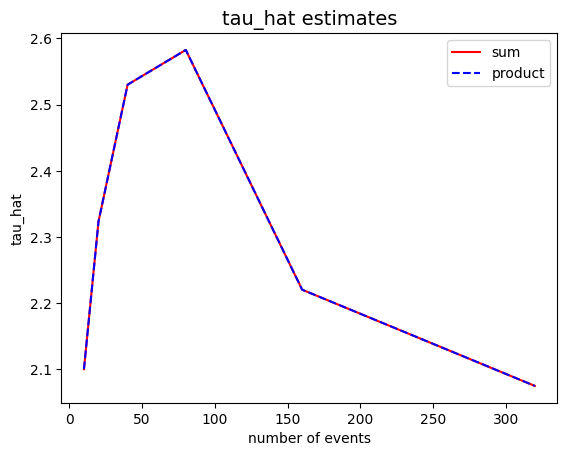
10.11.5. Exercise 10.5#
Graphically show that as the available sample size increases, the profile of the logarithm of the likelihood function becomes narrower.
To simplify visualization, use the logarithm of the ratio between the likelihood function and its maximum value:
\(LLR\:(\theta) = \log \left( \dfrac{\mathcal{L}(\theta)}{\mathcal{L}(\hat{\theta})} \right)\)
from likelihood import loglikelihood_ratio
sample_size = 10
fig, ax = plt.subplots ()
ax.set_title ('Log-likelihood ratio scan', size=14)
ax.set_xlabel ('tau')
ax.set_ylabel ('LLR')
tauaxis = np.linspace (0.5, 5., 10000)
colors = [
'thistle',
'plum',
'violet',
'orchid',
'fuchsia',
'mediumpurple',
'purple',
]
index = 0
while sample_size <= N_evt :
# create a subsample
subsample = sample[:int (sample_size)]
llr = np.arange (0., tauaxis.size)
for i in range (tauaxis.size) :
tau_hat = sezioneAureaMax_LL (loglikelihood, exp_pdf, subsample, 0.5, 5., 0.0001)
llr[i] = loglikelihood_ratio (tauaxis[i], exp_pdf, subsample, tau_hat)
plt.plot (tauaxis, llr, color = colors[index], label = str (sample_size) + ' events')
index = index + 1
sample_size = sample_size + 10
plt.legend ()
plt.show ()
---------------------------------------------------------------------------
KeyboardInterrupt Traceback (most recent call last)
Cell In[4], line 25
23 llr = np.arange (0., tauaxis.size)
24 for i in range (tauaxis.size) :
---> 25 tau_hat = sezioneAureaMax_LL (loglikelihood, exp_pdf, subsample, 0.5, 5., 0.0001)
26 llr[i] = loglikelihood_ratio (tauaxis[i], exp_pdf, subsample, tau_hat)
27 plt.plot (tauaxis, llr, color = colors[index], label = str (sample_size) + ' events')
File ~/work/UnimibFisicaLabStatPython/UnimibFisicaLabStatPython/book/lectures/Lecture_10/exercises/likelihood.py:81, in sezioneAureaMax_LL(g, pdf, sample, x0, x1, prec)
78 x3 = x0 + (1. - r) * (x1 - x0)
80 # si restringe l'intervallo tenendo fisso uno dei due estremi e spostando l'altro
---> 81 if (g (x3, pdf, sample) < g (x2, pdf, sample)):
82 x0 = x3
83 x1 = x1
File ~/work/UnimibFisicaLabStatPython/UnimibFisicaLabStatPython/book/lectures/Lecture_10/exercises/likelihood.py:39, in loglikelihood(theta, pdf, sample)
37 risultato = 0.
38 for x in sample :
---> 39 if (pdf (x, theta) > 0.) : risultato = risultato + log (pdf (x, theta))
40 return risultato
KeyboardInterrupt:
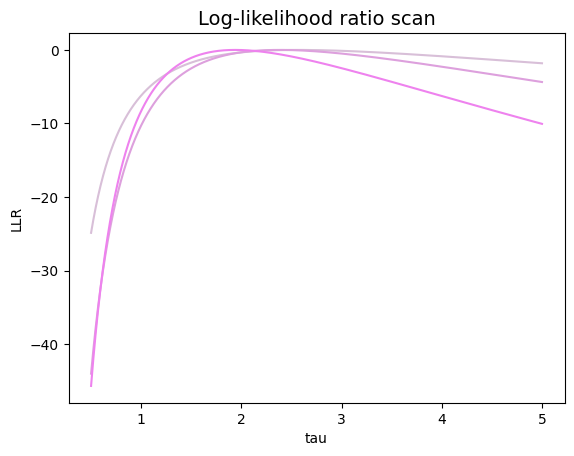
10.11.6. Exercise 10.6#
Use the bisection method to find the two points τ - στ and τ + στ related to Exercise 1.
Plot the log-likelihood profile, the estimator values, and the confidence interval along with the horizontal segment used for its determination.
from likelihood import intersect_LLR
tau_hat = sezioneAureaMax_LL (loglikelihood, exp_pdf, sample, 0.5, 5., 0.0001)
tau_hat_minusS = intersect_LLR (loglikelihood_ratio, exp_pdf, sample, 0.5, tau_hat, -0.5, tau_hat)
tau_hat_plusS = intersect_LLR (loglikelihood_ratio, exp_pdf, sample, tau_hat, 5., -0.5, tau_hat)
fig, ax = plt.subplots ()
ax.set_title ('Log-likelihood scan', size=14)
ax.set_xlabel ('tau')
ax.set_ylabel ('log likelihood')
# choose a reasonable range around tau_hat, measured in terms of the confidence interval
xMin = tau_hat_minusS - (tau_hat - tau_hat_minusS)
xMax = tau_hat_plusS + (tau_hat_plusS - tau_hat)
tauaxis = np.linspace (xMin, xMax, 10000)
llr = np.arange (0., tauaxis.size)
for i in range (tauaxis.size) :
llr[i] = loglikelihood_ratio (tauaxis[i], exp_pdf, sample, tau_hat)
plt.plot (tauaxis, llr, 'r')
limits = ax.get_ylim ()
plt.plot ([tau_hat, tau_hat], limits, color = 'blue')
plt.plot ([tau_hat_minusS, tau_hat_minusS], limits, color = 'blue', linestyle = 'dashed')
plt.plot ([tau_hat_plusS, tau_hat_plusS], limits, color = 'blue', linestyle = 'dashed')
plt.plot (plt.xlim (), [-0.5, -0.5], color = 'gray')
plt.show ()
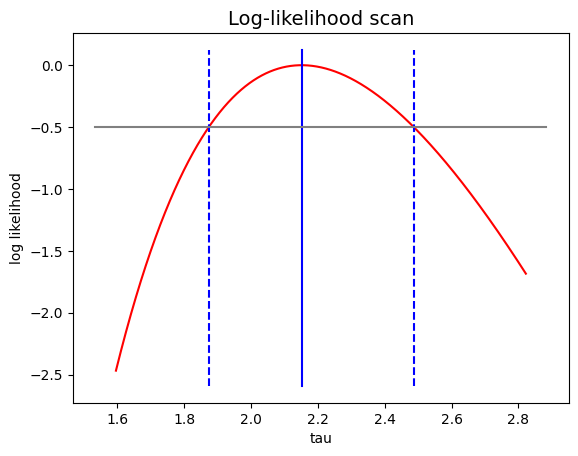
10.11.7. Exercise 10.7#
Using the toy experiments technique, plot the probability distribution of the τ estimator.
Overlay the generated histogram with the plot of the estimator and the confidence interval found in the previous exercise.
Compare the value of στ obtained in the previous exercise with the one calculated from the distribution of the numbers saved in the list.
from math import floor
from stats import stats
#tau_true = 2.
N_evt = 50
N_toys = 1000
tau_hats = []
# loop over toy experiments
for iToy in range (N_toys) :
singleToy = generate_exp (tau_true, N_evt)
tau_hat_toy = sezioneAureaMax_LL (loglikelihood, exp_pdf, singleToy, 0.5, 5., 0.0001)
tau_hats.append (tau_hat_toy)
xMin = 1.
xMax = 3.
bin_edges = np.linspace (xMin, xMax, floor (N_toys/20)) # edges o the histogram bins
fig, ax = plt.subplots ()
ax.set_title ('Tau_hat expected distribution', size=14)
ax.set_xlabel('tau_hat')
ax.set_ylabel('events in bin')
ax.hist (tau_hats,
bins = bin_edges,
color = 'orange',
)
limits = ax.get_ylim ()
plt.plot ([tau_hat, tau_hat], limits, color = 'blue')
plt.plot ([tau_hat_minusS, tau_hat_minusS], limits, color = 'blue', linestyle = 'dashed')
plt.plot ([tau_hat_plusS, tau_hat_plusS], limits, color = 'blue', linestyle = 'dashed')
toy_stats = stats (tau_hats)
print ('sigma ricavata dai toy: ', toy_stats.sigma ())
print ('sigma con il metodo grafico: ', 0.5 * (tau_hat_plusS - tau_hat_minusS))
plt.show ()
sigma ricavata dai toy: 0.2843224207360238
sigma con il metodo grafico: 0.30647450558155054
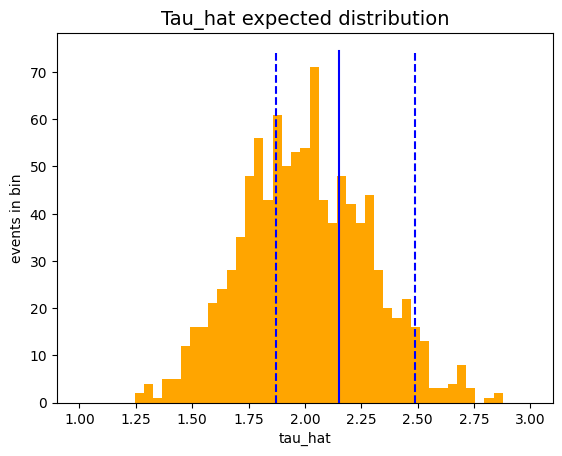
10.11.8. Exercise 10.8#
In the asymptotic regime, the distribution of the differences (τ - τtrue) / στ follows a Normal distribution.
Use the toy experiments method to fill the histogram of the differences, given a number of events per toy experiment.
Calculate the mean and sigma of the distribution of differences, and plot their values as a function of the number of events available for estimation, showing the trend on a graph with the number of events available on the horizontal axis and the parameter value on the vertical axis.
N_evt_big = 200
sample_size = 5
N_events = []
deviations = []
sigmas = []
while sample_size <= N_evt_big :
scarti = []
# loop over toy experiments
for iToy in range (N_toys) :
singleToy = generate_exp (tau_true, sample_size)
tau_hat_toy = sezioneAureaMax_LL (loglikelihood, exp_pdf, singleToy, 0.5, 5., 0.0001)
scarti.append (tau_hat_toy - tau_true)
toy_stats = stats (scarti)
deviations.append (toy_stats.mean ())
sigmas.append (toy_stats.sigma ())
N_events.append (sample_size)
sample_size = sample_size * 2
fig, ax = plt.subplots ()
ax.set_title ('average deviations', size=14)
ax.set_xlabel ('number of events')
ax.set_ylabel ('average deviation')
ax.errorbar (N_events, deviations, xerr = 0.0, yerr = sigmas)
plt.show ()
